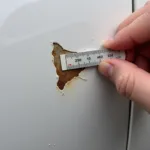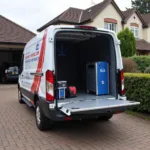Repairing car paint with a spray can seems daunting, but with the right techniques and a bit of patience, you can achieve professional-looking results and save money. This guide will walk you through the process of using a spray can for car paint repair, from preparation to the final touches.
Fixing minor scratches and chips yourself can prevent further damage like rust and maintain your car’s appearance. We’ll cover everything from choosing the right paint and materials to applying the paint correctly and achieving a smooth finish. diy car paint repair spray can explains some of the basics of DIY car paint repair. By following these steps, you can confidently tackle your car paint repair project and achieve impressive results.
Essential Materials for Car Paint Repair
Before you start, gather the necessary materials. Having everything ready will streamline the process and ensure a better outcome. You’ll need:
- Automotive spray paint (matched to your car’s color code)
- Primer (for bare metal)
- Clear coat
- Sandpaper (various grits)
- Masking tape and paper
- Tack cloth
- Rubbing compound
- Polishing compound
- Microfiber cloths
- Safety glasses and gloves
Preparing the Damaged Area
Proper preparation is crucial for a successful car paint repair. Start by thoroughly cleaning the area to be repaired with soap and water. Then, dry it completely. Next, use sandpaper to smooth out any rough edges or rust. Start with a coarser grit (e.g., 220-grit) and gradually move to finer grits (e.g., 1500-grit) for a smooth surface. how to repair a large paint chip on a car can help you understand how to address larger areas of damage. Mask off the surrounding areas with masking tape and paper to protect them from overspray. Finally, wipe the area with a tack cloth to remove any dust or debris.
Applying the Primer (If Necessary)
If you’ve sanded down to bare metal, apply a thin, even coat of automotive primer. Allow it to dry completely according to the manufacturer’s instructions. This provides a good base for the paint to adhere to and prevents rust formation. Lightly sand the primed area with fine-grit sandpaper (e.g., 1000-grit) to create a smooth surface for the paint.
Applying the Spray Paint
Shake the spray can vigorously for at least two minutes to ensure the paint is properly mixed. Hold the can about 8-10 inches away from the surface and apply thin, even coats, overlapping each pass by about 50%. Avoid applying thick coats, which can lead to runs and drips. car wash pressure hose peeled off paint on car repair discusses instances where high-pressure washing can damage car paint. Allow each coat to dry completely before applying the next. Usually, two to three coats are sufficient for good coverage.
Applying the Clear Coat
Once the color coat is completely dry, apply a few thin, even coats of clear coat. This will protect the paint and give it a glossy finish. Allow the clear coat to dry thoroughly according to the manufacturer’s instructions.
Finishing Touches: Wet Sanding and Polishing (Optional)
For a truly professional finish, you can wet sand the clear coat with very fine-grit sandpaper (e.g., 2000-grit) once it’s completely dry. This will remove any imperfections like orange peel or dust nibs. car paint repair steps offers a comprehensive guide to the different steps involved in car paint repair. Follow this up with rubbing compound and polishing compound to restore the shine. Finish with a coat of wax for added protection. fisheye on car paint repair covers how to fix fisheye blemishes during the repair process.
Conclusion
Repairing car paint with a spray can is a cost-effective solution for minor damage. By following the steps outlined above, you can achieve a professional-looking finish and restore your car’s appearance. Remember patience and attention to detail are key to success.
FAQs
- What type of spray paint should I use? Use automotive spray paint specifically designed for cars.
- How do I match the paint color? Find your car’s color code (usually located on a sticker in the doorjamb or owner’s manual) and purchase matching paint.
- Can I repair large scratches with a spray can? While possible, larger scratches might require professional repair for best results.
- How long does the repair take? The entire process, including drying time, can take several hours or even a day.
- What if the paint runs or drips? Let it dry completely, sand it down, and reapply.
Common Scenarios and Questions
- Scenario: Deep scratch that reaches the metal. Question: Do I need to apply primer? Answer: Yes, primer is essential when bare metal is exposed to prevent rust.
- Scenario: Minor scuff marks. Question: Do I need to sand the area? Answer: Light sanding might be necessary to smooth the surface before painting.
Further Resources
For more information, check out our other articles on car paint repair.
Need further assistance? Contact us via WhatsApp: +1(641)206-8880, Email: [email protected]. Our customer support team is available 24/7.


